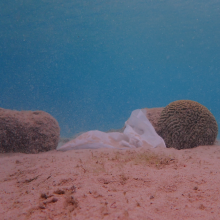Whether straws, plastic bottles or packaging, tones of plastic waste ends up in the oceans, the vast majority of it on the ocean floor out of the sight of human beings. The precise extent of the contamination, as well as the locations where particularly large deposits of plastic have formed and how it can be recovered is unclear. In the “MtecPla” project funded by the German Federal Ministry for Economic Affairs and Energy (BMWi), partners from industry and research, including the University of Stuttgart, are developing the world’s first monitoring technology, which is intended to identify and visualize plastic waste on the ocean floor.
Only a small proportion of the plastic waste in the world’s oceans is swimming on the surface, the rest of it sinks deep into the water or to the ocean floor, where it poses a hazard to plant and animal life. Previously there was no way of recovering plastic on the ocean floor in any large quantities. Traditional methods of monitoring, whereby divers would manually collect image data along lines or stretched cables (so-called transects), could only provide information about very limited geographical areas. These methods are also extremely time-consuming, costly and almost impossible in deeper water. They also generally don’t provide any georeferenced data to make it possible to find locations again, either to recover the plastic or to monitor the situation.
More efficient solutions are called for
The objective of the “MtecPla” project is to find a more efficient solution. Working together on the project are planblue GmbH, the German Research Center for Artificial Intelligence (DFKI), the tool manufacturers Kurt Synowzik Werkzeug u. Maschinenbau GmbH and the Institute of Biomaterials and Biomolecular Systems (IBBS) at the University of Stuttgart. The consortium is developing an innovative monitoring technology which can identify and determine plastic waste on an automated basis over large areas, as well as different types of plastic on the ocean floor. The new system should also record the condition of the plastic and combine the results with georeferenced data. In this way it becomes possible to do more than just estimate the level of pollution, but also to monitor any changes to the plastic waste over any given period of time and plan clean-up activities.
In order to plumb the depths where no human diver can reach and to cover a greater area, it should also be possible to use the new system in conjunction with remote-controlled or autonomous underwater vehicles. The information obtained from the dives is understandable even without any expert knowledge thanks to color-coded maps created automatically, which make it useful in the war on plastic in a variety of ways.
Hyperspectral imaging and powerful AI algorithms
The project partners use hyperspectral cameras to carry out their project. These cameras record more than just information about the red, green and blue colors for each pixel, but also record light output in hundreds of different wavelengths in the visible and near-infrared range. This is combined with artificial intelligence. By using the distinctive reflection spectra, the algorithms can be trained to detect the plastic waste on the ocean floor with precision within the total amount of data collected, as well as to classify it and extract the necessary data to create a visual representation. To ensure that the technology works under water, a watertight casing should be constructed in “MtecPla” which makes sure that the light reaches the camera perfectly.
Testing campaigns in the laboratory and under real-world conditions
The components developed are tested and evaluated under controlled laboratory conditions by IBBS at the University of Stuttgart. To do this, the researchers produce a special sediment-plastic mixture, which is assessed fully at the microscopic level. A wide range of realistic contaminants can already be investigated in advance by varying the proportions of individual types of plastic as well as their size and shape. Since periphytic organisms and the process of degradation may potentially impair the signal processing, aged material is also taken into consideration in the tests so that any impairments can be recognized and remedied at an early stage.
A 20 m³ tank is available at the Robotics Innovation Center of the DFKI to perform the tests. Since the tank can either be darkened or made cloudy, it provides similar conditions to those seen on the ocean floor. The new system should then also be tested outside the laboratory at the bottom of a lake. This means that the technology developed as part of the project can be used to detect plastic in all aquatic habitats. The potential for entirely new areas of application also open up, such as monitoring underwater structures like offshore wind farms, aquacultures and coastal engineering works. The software can also be used to process hyperspectral images outside the water.
Expert Contact:
Asst. Prof. Franz Brümmer, University of Stuttgart, Institute of Biomaterials and Biomolecular Systems (IBBS),
phone: +49 711 685 65083, e-mail


